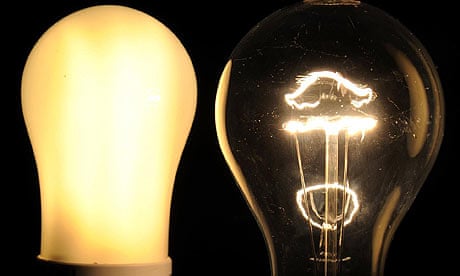From Tuesday the 100-watt incandescent lightbulb will join tape cassettes and typewriters as defunct consumer items, making way for more environmentally friendly compact fluorescent lamps, as mandated by the EU.
From a green point of view, the phasing out of the 100W bulb, which has been around for more than 100 years, is a no-brainer. Energy-saving bulbs use 80% less electricity than standard ones, therefore cutting bills – by around £45 a year – and reducing carbon emissions. The Energy Saving Trust says the vast majority of the 600m lightbulbs in UK homes are inefficient tungsten filament bulbs, and phasing them out will make a real difference to national energy consumption.
Yet the passing of the standard lightbulb has seen an outpouring of pre-emptive nostalgia, as well as considerable vitriol at its replacement. There is a Facebook page called I Hate Energy Saving Light Bulbs, where Margot K Juby curses the new bulbs: "I got a cactus spike in my foot late one night & had to use a torch to see it! Stupid lightbulb was useless."
Rachel Cooke, of the Observer, confessed to spending £30 – the entire contents of her wallet – on incandescent lightbulbs that were on special offer. The Daily Mail, which considers directives from Brussels the work of the devil, mounted a campaign to keep the old-fashioned bulbs, to the point of giving them away by the thousand. The paper even managed to work up a scare story about how the new bulbs "can give you skin cancer". That claim may be overwrought but some charities have genuine concerns about people with light-sensitive health conditions such as an extreme form of lupus, for whom exposure to the new lightbulbs can lead to a reddish-purple rash and vomiting.
Health concerns aside, the intense feelings generated by the imminent extinction of the 100W lightbulb are a stark illustration of the uphill battle facing those who hope to wean consumers away from planet-spoiling behaviour. If so many people are so attached to something as trivial as lightbulbs, what hope is there of cutting the use of cars and planes?

Comments (…)
Sign in or create your Guardian account to join the discussion